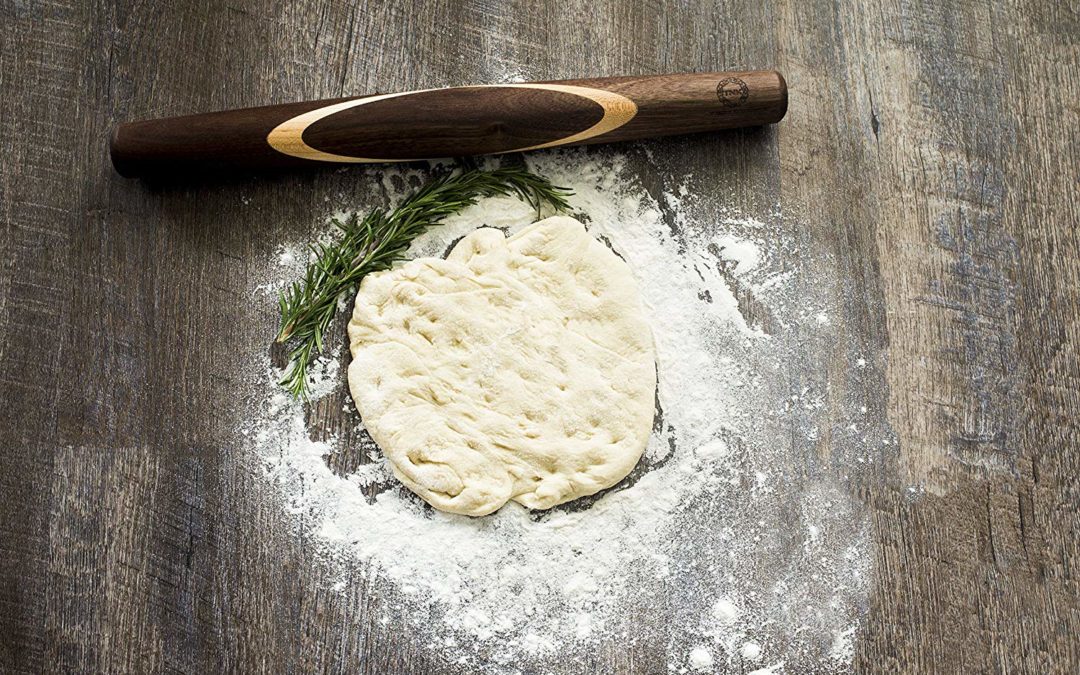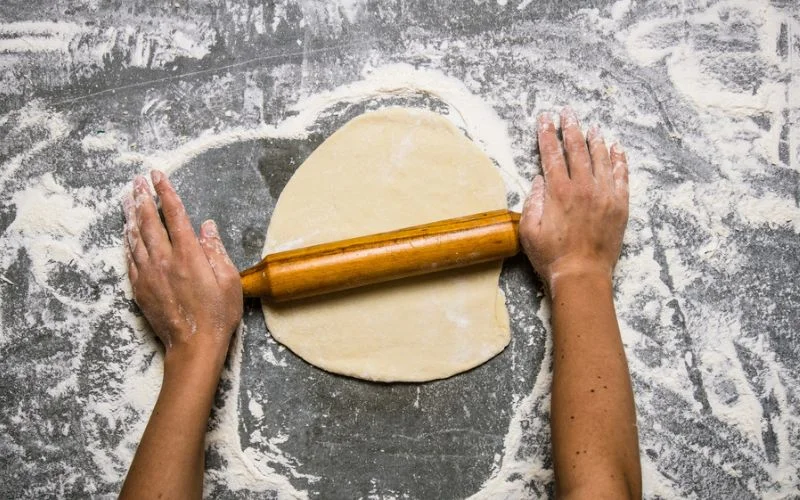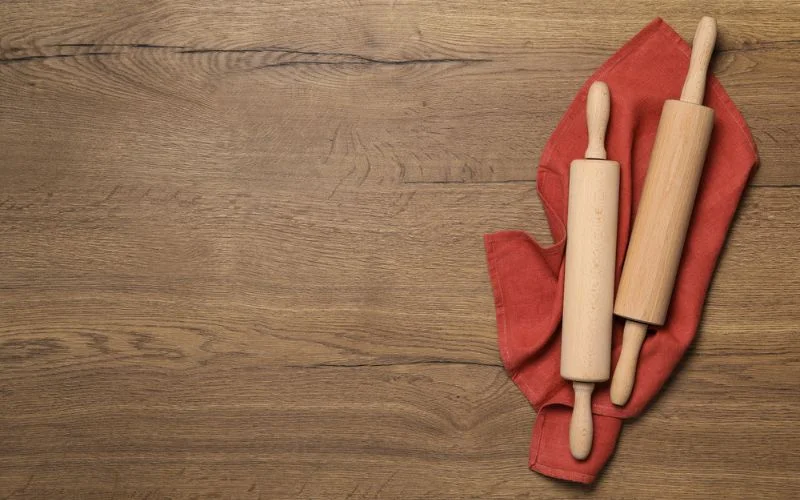A rolling pin is such a simple cooking utensil that it is easy to overlook its importance. If you do not bake much, you might not know you are missing one until the time comes when you need one. Rolling pins should be simple and durable. A good rolling pin should last its user a lifetime. Buy Here: Rolling Pin
Many people purchase the first rolling pin that they see with no regard for quality. It seems a little silly to think that one should do research before purchasing something as simple as a rolling pin, but it is not silly at all. A good rolling pin will make all the difference. Read on to learn how to choose the perfect rolling pin for you.
Selecting the Rolling Pin Length
Consider the task at hand when selecting a rolling pin. You, as the cook, should think about what you will be using the rolling pin for the most. This is an incredibly important step that should not be overlooked. Rolling pins come in all sorts of shapes. Different sizes and dimensions are designed for different cooking styles and different recipes.
A rolling pin that is too long or too short can:
- Leave the cook with an unwieldy utensil
- Be tedious to use if it does not cover enough surface area
- Be hard to store when not in use
- Take up too much space when in use
- Roll dough unevenly if many passes are required
If a rolling pin is too long, it can be awkward to use. If it covers too much surface area, then you could struggle to work efficiently with your hands spread too far. Being able to maintain control over the working area is the key to cooking any recipe that requires dexterity and precision. Rolling pins that are too large will do a cook no favors.
If a rolling pin is too short, it can require you to roll the dough several times. This can leave the dough uneven, which will look bad, and cook improperly. The rolling pin should work effectively and not require you to re-roll it several times. If the pin requires you to go over the dough several times, it is probably too short or too small for you.
Eighteen inches from handle to handle is a safe length for a rolling pin. This is enough to cover almost any amount of dough that you would be rolling. This length would not be too much to handle when processing smaller, more intricate tasks. You should make sure that the length of your rolling pin is somewhere in that sweet spot before you buy.
Selecting the Rolling Pin Weight
A rolling pin’s weight can be an asset or a liability. Too much weight typically results in really thin dough, while too little weight requires you to strain yourself more while rolling to achieve the desired dough thickness. Your rolling pin’s weight can make or break a recipe. Like with length, you should not overlook weight when selecting a rolling pin.
A rolling pin that is too heavy or too light can:
- Make the dough way too thin for the recipe you are preparing
- Be hard for you to handle while cooking
- Cause you too much strain while cooking
- Feel awkward to use while cooking
- Make you dread rolling dough when preparing recipes
If a rolling pin is too heavy, it might flatten the dough out too much. Also, the heavy rolling pin can cause fatigue in your forearms and be awkward for you to use. If the rolling pin is too heavy, rolling the dough is sure to become a chore. You should avoid a rolling pin that is too heavy if you want consistent dough production, which you do.
If a rolling pin is too light, it will be much harder to use than an appropriately weighted pin. You will have to apply much more pressure on the dough through the rolling pin if the rolling pin is too light on its own. This might cause you too much strain and actually hurt your muscles. You would be unlikely to use that rolling pin again. What a waste!
One to two pounds seems to be a good mid-range weight to look for in a rolling pin. It is so much easier to roll out dough when you are not having to take on extra strain bearing down on your pin or fight with excess weight to manipulate the pin’s movements. Look for a rolling pin somewhere around that one to two-pound range, and it will be perfect.
Selecting the Rolling Pin Material
Certain materials will perform different tasks better than others will. It is important for you to assess your particular needs when selecting your rolling pin material. Some materials hold onto dough which leads to tears and messy-looking finished products. Your pin’s material should be chosen with careful consideration.
Typical rolling pin materials are:
- Marble
- Hardwoods like maple, black walnut, mahogany, oak, and cherry
- Silicone
Marble rolling pins are great to put in the freezer and get cold. The dough has to stay at a cool temperature to avoid becoming tacky and sticking to the pin. Chilled marble rolling pins are great utensils for rolling dough. These pins are often the most expensive ones on the market, so invest wisely! They are also heavy.
Hardwood rolling pins are the most common rolling pins out there. They work really well because they do not conduct heat at all. This limits the transfer of heat from your hands to the dough itself, ensuring that the dough is very easy to work with. People love the classic way that hardwood rolling pins look, and their prices are reasonable as well.
Silicone rolling pins are the most affordable pins available. They do not conduct much heat, which goes a long way towards keeping dough cool. Anyone who wants to prioritize affordability over aesthetics should consider choosing a silicone rolling pin.
Selecting the Rolling Pin Style
Style selection comes down to personal preference. It depends on what you like or do not like about the shape of a specific rolling pin style. We, at Fast Easy Bread, greatly prefer the French style of Rolling pins. At the end of the day, you should choose what works best for you. The different styles of rolling pins all work well for the same recipes. We like the French style because we think it gives more control when rolling out dough. You can easily roll out a circle by starting from the middle and rolling out from there. See this article about “How To Use A Tapered French Rolling Pin.”
The three basic rolling pin styles are:
-
- Shaker rolling pins
- American rolling pins
Shaker rolling pins are made of hardwood and have fixed handles. This style is the traditional, familiar rolling pin style that is used in the United States. These beautiful rolling pins are simple, rustic, and functional. They perform well and allow users to work with their fingers safely above the surface of the working area.
American rolling pins look just like shaker rolling pins, but the handles swivel and allow the shafts of the rolling pins to rotate against the working surface. Marble rolling pins are usually made in this style. The rotation is a convenient feature that many cooks have certainly come to appreciate, but this style does require more cleaning and upkeep. The olther downfall is that it has moving parts and can break after some period of use.
French rolling pins are simple and straightforward. They are basically smoothed batons of wood with slightly tapered ends. This is a very minimalist and attractive style that many cooks have come to appreciate in recent years. Cooks that use these pins like the fact that they can feel the dough better through the pin itself.
Selecting the Rolling Pin Design
Rolling pins can be more than a kitchen tool or utensil. They can be a staple for decoration if the design is unique enough. For example, some marble rolling pins come with cradles or stands to display in the kitchen. Our Top Notch Kitchenware rolling pins are all beautiful and there are some really unique designs of inlayed wood for display. The Black Walnut with Sugar Maple Celtic Knot rolling pin is a fan favorite and best seller sure to spice up the looks of your kitchen. It is short enough to fit in a standard drawer but I promise you won’t want to leave it in there.
Whatever you choice for rolling pin is, I hope you enjoy using it. Happy Baking!!!
Frequently Asked Questions
Do professional bakers prefer a specific type of rolling pin?
Many professionals have preferences based on tasks, but hardwood or French-style pins are popular due to their control and efficiency.
Do silicone rolling pins absorb flavors or odors?
Silicone is non-porous and doesn’t absorb flavors or odors, making it ideal for varied baking tasks.
What’s the significance of a rolling pin’s weight in baking?
Weight affects the thickness of the dough and user strain. Balance is key for consistent and comfortable baking.




Where there is a will, there is a way.